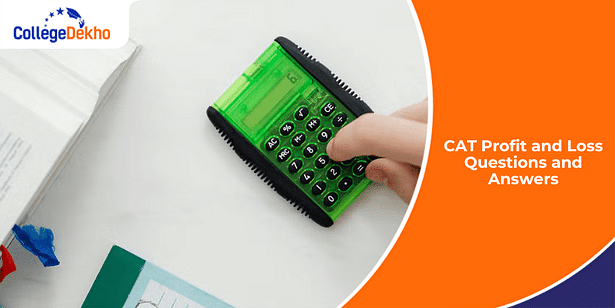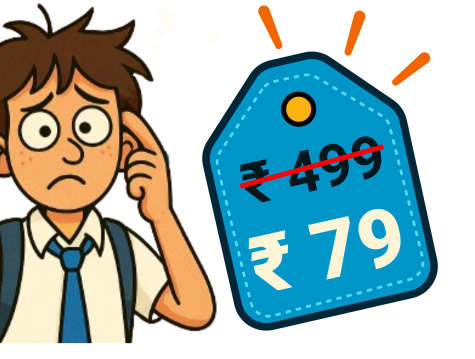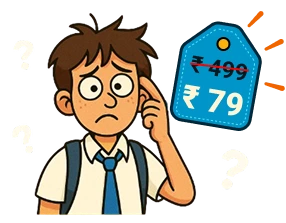
Looking for CAT 2024 Profit and Loss Questions and Answers? Questions on Profit and Loss are now a regular part of the CAT Quant section, with around 3-4 questions appearing every year. Understanding basic concepts and learning a few shortcut formulas can help you solve these questions quickly. These concepts often appear in the Data Interpretation section, making them doubly important for your overall preparation for the CAT 2024 exam . Candidates can check here 20+ selected Profit and Loss CAT questions with answers, based on previous year question papers.

Also Read:
Profit and Loss CAT Formulas
For the CAT 2024 exam, understanding the fundamental concepts of profit and loss is crucial as most questions can be tackled directly using the right formulas.
Cost Price (C.P): T he amount paid to purchase or manufacture an article.
Selling Price (S.P): The price at which a product is sold.
Marked Price (M.P): The price at which an article is labeled or marked.
➔ When S.P > C.P: Profit (P) = S.P−C.P
➔ When C.P > S.P: Loss (L)=C.P−S.P
➔ Profit Percentage: Profit/C.P × 100 | Loss Percentage: Loss/C.P × 100
➔ Discount = M.P – S.P
➔ Discount Percentage: Discount/M.P × 100
➔ Total increase in price due to two successive increases of X% and Y%: (X + Y + XY/ 100)%
➔ If two items are sold at the same price (each at Rs. x), one at a profit of P% and the other at a loss of P%, then overall loss: (P2 /100) % | Absolute loss = (2P2x / 1002−P2 )
➔ If the C.P of two items is the same and by selling one he earns p% profit and on the other he incurs p% loss, then there will be no loss or gain.
➔ If a trader sells at C.P but uses false weight: Gain% = (Difference/True Weight) × 100 %
➔ Buy x get y free, Percentage Discount: = (y/x+y) × 100 (here x+y articles are sold at C.P of x articles.)
➔ When two successive discounts of a% and b% are given: Resultant discount = a+b − (a × b /100)
➔ If the C.P of x articles is equal to the S.P of y articles: Resultant profit or loss percentage = (y-x / y) × 100
Also Read : CAT 2024 Quant Formula PDF Download
CAT 2024 Profit and Loss Questions & Answers
Check out the following most common questions on CAT Profit and Loss along with their solutions and answers:1. A merchant purchases a cloth at a rate of Rs.100 per meter and receives 5 cm length of cloth free for every 100 cm length of cloth purchased by him. He sells the same cloth at a rate of Rs.110 per meter but cheats his customers by giving 95 cm length of cloth for every 100 cm length of cloth purchased by the customers. If the merchant provides a 5% discount, the resulting profit earned by him is
(a) 4.2%
(b) 9.7%
(c) 15.5%
(d) 16%
Solution
It is given that a merchant purchases a cloth at a rate of Rs.100 per meter and receives 5 cm length of cloth free for every 100 cm length of cloth purchased by him.
Hence, the cost price of 105 cm clothes is 100 rupees.
It is also known that he marked the price of 100 cm clothes as 110 rupees, and gave a 5% discount, and he cheated his customers by giving 95 cm length of cloth for every 100 cm length of cloth purchased by the customers.
Hence, the selling price of 95 cm clothes is 110*(19/20) rupees.
Therefore, the selling price of 105 cm clothes is 115.5 rupees.
Hence, the profit is 15.5%
The correct option is C
2. I sell 16 sheep at a gain of 12.5% and 20 more at a certain gain percent. If 1 gained 25% on the whole, how much percent gain did I make on the latter number?
(a) 20%(b) 25%
(c) 30%
(d) 35%
Solution
On the whole, I gain 25%
Therefore, I should get the cost price of 36 × 125/100 = 45 sheep
But I sell the first lot at a gain of 12.5%
Hence by selling 16 sheep, I get the cost price of 16 × 112.5/100 = 18 sheep
Therefore, I should get the cost price of 45-18=27 sheep by selling the second lot of 20. Hence my gain there should be 7/20 * 100 = 35
The correct option is D
Also Read
:
How to Prepare for CAT Quantitative Ability (QA) 2024
3. A farmer buys 240 cows. He sells some of them at a gain of 20% and the remaining at a gain of 30%. If he gains 28% on the whole, then how many did he sell at a gain of 20%?
(a) 40(b) 48
(c) 54
(d) 28
Solution
Let him sell x cows at a gain of 20% and y cows at a gain of 30%.
Therefore, 0.2x + 0.3y = -0.28(x+y)
=> y=4x, Therefore, x+4x=240 =>x=48.
The correct option is B
4. Gita sells two objects A and B at the same price such that she makes a profit of 20% on object A and a loss of 10% on object B. If she increases the selling price such that objects A and B are still sold at an equal price and a profit of 10% is made on object B, then the profit made on object A will be nearest to
(a) 42%(b) 45%
(c) 47%
(d) 49%
Solution
Let us assume the initial selling prices of A and B is p.
Given, she made profit of 20% on A => 1.2 * c = p => c = 5p/6 => cost of A is 5/6 p
Given, she made a loss of 10% on B => 0.9 * c = p => c = 10p/9 => cost of B is 10/9p
Now, she sold them at a price such that a 10% profit is made on B
=> Selling price = s = 11/10 * 10/9 p => 11/9 p
=> Profit % on A = (11/9 - 5/6)(5/6)× 100 = 46.66% = nearly 47%
The correct option is C
Also Read
:
CAT 2024 Quant Topic-Wise Questions
5. Jayant bought a certain number of white shirts at the rate of Rs 1000 per piece and a certain number of blue shirts at the rate of Rs 1125 per piece. For each shirt, he then set a fixed market price which was 25% higher than the average cost of all the shirts. He sold all the shirts at a discount of 10% and made a total profit of Rs.51000. If he bought both colors of shirts, then the maximum possible total number of shirts that he could have bought is
Solution
Let the number of white shirts be m, and the number of blue shirts be n. Hence, the total cost of the shirts = (1000m + 1125n), and the number of shirts is (m + n)
The average price of the shirts is 1000m + 1125n / m + n. It is given that he set a fixed market price which was 25% higher than the average cost of all the shirts. He sold all the shirts at a discount of 10%.
Hence, the average selling price of the shirts =
(1000m + 1125n / m + n)× 5/4× 9/10 = 9/8 (1000m + 1125n / m + n)
The average profit of the shirts = 9/8 (1000m + 1125n / m + n) - (1000m + 1125n / m + n) = 1/8 (1000m + 1125n / m + n)
The total profit of the shirts = 1/8 (1000m + 1125n / m + n) x (m + n) = 1/8 (1000m + 1125n)
Now,
=>1/8 (1000m+1125n)=51000
=> 1000m+1125n=51000× 8=408000
Now to get the maximum number of shirts, we need to minimize n (since the coefficient of n is greater than the coefficient of m), but it can't be zero. Therefore, m has to be maximum.
m = 408000−1125n / 1000
The maximum value of m such that m, and both are integers is m = 399, and n = 8 (by inspection)
Hence, the maximum number of shirts = m+n = 399+8 = 407
6. A dealer sells a horse for Rs.400, making a profit of 25%. He sells a second horse at a loss of 10% and on the whole makes neither profit nor loss. What did the second horse cost him?
(a) Rs. 100(b) Rs. 600
(c) Rs. 800
(d) Rs. 400
Solution
In the given question "The dealer sells two horses, one for Rs.400, making a profit of 25% and the other horse at a loss of 10% and makes neither profit nor loss on the whole."
Let the cost price of the second horse = Rs.x i.e., 320 + x = 400 + 9x/10 ( since 400 x 100/125 = 320) => x = Rs.800.
The correct option is C
Also Read
:
7. If toffees are bought at the rate 18 for a rupee, then how many of them must be sold for a rupee to gain 20%?
(a) 14
(b) 15
(c) 16
(d) 12
Solution
18 x 100 p = 120x => x = 15.
The correct option is B
8. Amal buys 110 kg of syrup and 120 kg of juice, syrup being 20% less costly than juice, per kg. He sells 10 kg of syrup at 10% profit and 20 kg of juice at 20% profit. Mixing the remaining juice and syrup, Amal sells the mixture at ₹ 308.32 per kg and makes an overall profit of 64%. Then, Amal’s cost price for syrup, in rupees per kg, is
Solution
18 x 100 p = 120x => x = 15.
The correct option is B
Solution for Question 8
Total syrup - 110 kg
Total juice - 120 kg
It is given, cost price of syrup is 20% less than the cost price of juice.
Let the cost price of juice per kg be 10CP
Cost price of syrup per kg is 8CP
10kg syrup -> cost price = 80CP
It is given, 10kg syrup is sold at 10% profit. This implies selling price = 1.1*80CP = 88CP
20kg juice -> cost price = 200CP
It is given, 20kg juice is sold at 20% profit. This implies selling price = 1.2*200CP = 240CP
It is given, Mixing the remaining juice and syrup, Amal sells the mixture at ₹ 308.32 per kg
Selling price of the remaining mixture = 308.32*200 = Rs 61664
Total S.P = 61664 + 328CP
Total C.P = 880CP + 1200CP = 2080CP
Overall profit = 64%
61664+328 CP = 164/100 (2080 CP)
Solving, we get CP = 20
Cost price for syrup per kg = 8CP = 8*20 = Rs 160
Also Read
:
Topics You Should Not Skip in CAT Quant 2024
9. Raj invested ₹10000 in a fund. At the end of the first year, he incurred a loss but his balance was more than ₹ 5000. This balance, when invested for another year, grew and the percentage of growth in the second year was five times the percentage of loss in the first year. If the gain of Raj from the initial investment over the two year period is 35%, then the percentage of loss in the first year is
(a) 5
(b) 15
(c) 17
(d) 10
Solution
Raj invested Rs 10000 in the first year. Assuming the loss he faced was x%.
The amount after 1 year is 10,000*(1 - x/100). = 10000 - 100*x.
Given the balance was greater than Rs 5000 and hence x < 50 percent.
When Raj invested this amount in the second year he earned a profit which is five times that of the first-year percentage.
Hence the amount after the second year is : (10000 - 100x)(1+ 5 . x/100)
Raj gained a total of 35 percent over the period of two years and hence the 35 percent is Rs 3500.
Hence the final amount is Rs 13,500.
(10000 - 100x)(1+ 5 . x/100) = 13,500
(100+5⋅x)⋅(100 − x) = 13500
10000 - 100*x +500*x - 5*x2 = 13500
5x2−400x+3500 = 0
Solving the equation the roots are :
x = 10, x = 70.
Since x < 50, x = 10 percent.
The correct option is D
10. Amal purchases some pens at ₹ 8 each. To sell these, he hires an employee at a fixed wage. He sells 100 of these pens at ₹ 12 each. If the remaining pens are sold at ₹ 11 each, then he makes a net profit of ₹ 300, while he makes a net loss of ₹ 300 if the remaining pens are sold at ₹ 9 each. The wage of the employee, in INR, is
Solution
Let the number of pens purchased be n. Then the cost price is 8n. The total expenses incurred would be 8n+W, where W refers to the wage.
Then SP in the first case = 12× 100+11× (n−100)
Given profit is 300 in this case: 1200+11n-1100-8n-W=300 =>3n-W = 200
In the second case: 1200+9n-900-8n-W=-300 (Loss). => W-n = 600.
Adding the two equations: 2n = 800
n = 400.
Thus W = 600 + 400 = 1000
Also Read
:
CAT 2024 Quant Secret Preparation Tricks
11. A man's petrol bill in July is Rs.200. In August, the price of petrol increased by 10% and its consumption was reduced by 10%. Find his petrol bill in August.
(a) Rs.190
(b) Rs. 210
(c) Rs. 200
(d) Rs. 198
Solution
Let the consumption in July = x litres,
Therefore, price of petrol = Rs. 200/x
=> Petrol bill in August = (0.9x) x(1.10)x 200/x= Rs.198.
The correct option is D
12. A bike costs Rs.48000. Its value depreciates by 30% in the first year and in each subsequent year the depreciation is 20% of the value at the beginning of that year. The value of the bike after 3 years will be
(a) Rs. 21504
(b) Rs. 26880
(c) Rs. 38400
(d) Rs. 39480
Solution
The required value of the bike after 3 years = 48000 (70/100) (80/100)2 = Rs .21504
The correct option is A
13. Anil, Bobby, and Chintu jointly invest in a business and agree to share the overall profit in proportion to their investments. Anil’s share of investment is 70%. His share of profit decreases by ₹ 420 if the overall profit goes down from 18% to 15%. Chintu’s share of profit increases by ₹ 80 if the overall profit goes up from 15% to 17%. The amount, in INR, invested by Bobby is
(a) 2000
(b) 2400
(c) 2200
(d) 1800
Solution
Let the amount invested by Anil Bobby and Chintu be x, y, and z.
Considering x+y+z = 100*p.
Given Anil's share was 70 percent = 70*p.
As per the information provided :
His share of profit decreases by ₹ 420 if the overall profit goes down from 18% to 15%.
Since the profits are distributed in the ratio of their investments :
With a 3% decrease in the profits the value of profit earned by A decreased by Rs 420 which was 70 percent of the total invested.
Hence for all three of them would be combinedly losing (420)⋅(10/7) = 600
Hence 3 percent profit was equivalent to Rs 600.
The initial investment is equivalent to Rs 20000.
This is the total amount invested.
Chintu's profit share increased by Rs 80 when the profit percentage increased by 2 %. A 2% increase in profit is equivalent to Rs 20000*2/100 = Rs 400.
Of which Rs 80 is earned by Chintu which is 20% of the total Rs 400.
Hence he invested 20% of the total amount.
Bobby invested the other 10 percent.
10 percent of Rs 20000 = Rs 2000
The correct option is A
14. A person spent Rs 50000 to purchase a desktop computer and a laptop computer. He sold the desktop at 20% profit and the laptop at 10% loss. If overall he made a 2% profit then the purchase price, in rupees, of the desktop is
Solution
Let the price of desktop and laptop be x,y respectively.
Given,
x+y=50000...(i)
12.x+0.9y=50000(1.02)=51000...(ii)
(ii)-0.9(i) gives
0.3x=6000=> x=20000.
15. Vivek bought 5 dozen apples at the rate of Rs.15 per dozen. He spent Rs.15 on transportation. If he sold the apples at the rate of Rs.24 per dozen, what was his profit percentage?
(a) 25%
(b) 30%
(c) 33.33%
(d) 60%
Solution
The Cost Price (C.P) of 1 dozen apples = Rs.15.
Hence, the C.P of 5 dozen apples = 15 x 5 = Rs.75.
Adding Rs.15 towards transportation cost, the total cost price of 5 dozen apples becomes Rs.90.
Now, the Selling Price (S.P) of 1 dozen apples = Rs.24.
Hence, the Sales Revenue of 5 dozen apples = 24 x 5 = Rs.120.
Thus, Net Profit = Sales Revenue - Cost Price = 120 - 90 = Rs.30.
The Profit is always expressed as a percentage to cost price. Required answer = (30/90) x 100 = 33.33%.
The correct option is C
16. A shopkeeper purchases several articles at the rate of 11 for Rs.10 and sells them at the rate of 10 for Rs.11. What would be the profit earned by him?
(a) 24%
(b) 40%
(c) 50%
(d) 200%
Solution
Cost Price for 11 articles = Rs.10 .... (I)
Sales Price for 10 articles = Rs.11 .... (II)
Sales Price for 11 articles = Rs.12.1 (III)
Thus, required profit = [(12.1-10)/10] x 100 = 21%.
The correct option is D
17. A dishonest dealer pretends to sell at the cost price but earns a profit of 25% by underweighting. What weight must he be using for 1 kg?
(a) 750 gm
(b) 800 gm
(c) 500 gm
(d) 875 gm
Solution
Let the false weight be x gm.
Thus, the profit made is through sale of (100-x) gm
Hence, we have, 100-x/x = 25% => x = 800 gm
The correct option is B
Also Read
:
CAT 2024 Geometry Formula PDF
18. A man buys 35 kg of sugar and sets a marked price in order to make a 20% profit. He sells 5 kg at this price, and 15 kg at a 10% discount. Accidentally, 3 kg of sugar is wasted. He sells the remaining sugar by raising the marked price by p percent so as to make an overall profit of 15%. Then p is nearest to
(a) 22
(b) 35
(c) 25
(d) 31
Solution
Let the cost price of 1kg of sugar = Rs 100
The total cost price of 35 kg = Rs 3500
Marked up price per kg = Rs 120
GIven, the final profit is 15% => Final SP of 35 kg = 3500 *1.15 = Rs 4025
First 5 kg's are sold at 20% marked up price => SP1 = 5⋅100⋅1.2 = Rs 600
Next 15 kgs are sold after giving 10% discount => SP2 = 15⋅100⋅1.2⋅0.9 = 1620
3 kgs of sugar got wasted
=> 23 kg of sugar was sold at Rs (600 +1620) = Rs 2220
Remaining 12kg should be sold at Rs 4025 - 2220 = Rs 1805
=> SP of 1kg = 1805/12 ≃ 150
Hence, the seller should further mark up by 150-120/120 . 100 = 25%
The correct option is C
19. What is the cost price of an article, if a loss of 16% is incurred by selling it for Rs.168?
(a) Rs. 200
(b) Rs. 180
(c) Rs. 220
(d) Rs. 210
Solution
Let the cost price of the article be Rs. 'X'. Thus, we get, X - (16% of X) = Rs. 168 = X = Rs. 200
The correct option is A
20. On selling a pen at 5% loss and a book at 15% gain, Karim gains Rs. 7. If he sells the pen at 5% gain and the book at 10% gain, he gains Rs. 13. What is the cost price of the book in Rupees?
(a) 95
(b) 85
(c) 80
(d) 100
Solution
Assuming the cost price of pen = 100p and the cost price of book = 100b
So, on selling a pen at 5% loss and a book at 15% gain, net gain = -5p+15b = 7 ....1
On selling the pen at 5% gain and the book at 10% gain, net gain = 5p+10b = 13 .....2
Adding 1 and 2 we get, 25b=20
Hence 100b= 20*4=80,
The correct option is C
Hopefully, the practice questions for CAT Profit & Loss were helpful to aspirants! Check out the articles below to learn more about CAT 2024!
Related Articles:
If you have any queries, write to us on the
CollegeDekho QnA Zone
. For personalized assistance with MBA admission 2024, fill out our
Common Application Form (CAF)
or call our helpline number 1800-572-9877.
Are you feeling lost and unsure about what career path to take after completing 12th standard?
Say goodbye to confusion and hello to a bright future!

Was this article helpful?




















Similar Articles
25+ CAT VARC Practice Questions with Solutions PDF Download
Topics You Should Not Skip in CAT Quant 2025
CAT 2025 Quant Topic-wise Weightage
CAT 2025 Arithmetic Questions with Answers
15+ CAT 2025 Percentage Questions: Formulas, Tips and Tricks
CAT 2025 Preparation Strategy for Repeaters